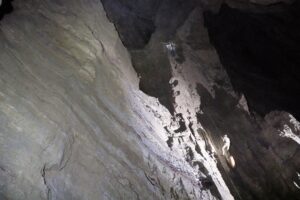The Cave of Hanging Snakes in Mexico sounds like something out of an Indiana Jones movie. In this 20m-wide limestone grotto, snakes slither down from the ceiling and snack on bats in mid-flight.
The cave lies near the village of Kantemó, 289km from touristy Cancun. Although it is hidden deep in the jungle, locals have known about this place for over two centuries.
Only about 300 people visit the place yearly, although its popularity is growing, thanks to the Internet. Visitors pay 630 pesos ( about $36) and must wear protective gear such as hard hats, masks, and gloves. This is because certain sections can be dangerous from the abundant bat droppings.
Cultural background
According to old Mayan traditions, caves were holy sites — symbols of fertility and doorways to the netherworld where certain gods lived. The resident bats who lived here also figured in the Mayan religion. Messengers from the underworld, they symbolized death and sacrifice.
Lastly, snakes themselves dominated the Mayan culture. It featured the serpent deity Kukulkan, and snakes also had a mythological role as vehicles of planetary movement.

A snake eats a bat. Photo: Alberto Friscione/Zenger
Cave’s formation
Over millions of years, rainfall and erosion carved out the limestone cave’s porous rock. This created networks of cracks and fractures where curious, slithering visitors from surrounding forests decided to take up permanent residence.
Dinnertime
They like this type of environment because of its consistent temperatures and abundant food supply. They are at the top of the food chain in this cave. Using their heightened senses and incredible skill in sensing vibrations, they catch their prey with pinpoint accuracy. Their diet consists of lizards, small rodents and of course, bats. To catch these creatures, they just hang vertically and wait…
Here, the six species of bats in the cave occupy the bottom of the food chain. Around 300,000 bats swarm this cave after scouring the jungle for their dinner. Then they settle down for the night, hanging upside down from the ceiling. Unfortunately, they can only get a good night’s sleep if they stay perfectly still. Should they move, they will become dinner themselves. The snakes will feel the brush of their wings and lunge without hesitation.

Biologist Bayona Miramontes gets close to a snake. Photo: Alberto Friscione/Zenger
The kill is hardly instant. Biologist Arturo Enrique Bayona Miramontes studied these creatures for over three months, witnessing how the snake asphyxiates the bat by breaking its wings. But have no fear: The snakes are deaf and blind and harmless to humans. They belong to a non-venomous variety called the tropical mousetrap. So you can get up pretty close to check them out.
Miramontes says that this environment is a “balanced ecosystem that could be threatened by even the smallest changes.” This is why local authorities have strict guidelines for visitors. Only 10 people can go inside the cave at a time.
The cave itself lies in an area populated by a small Mayan community, which promotes ecotourism. They market their village and the surrounding attractions as a reptile lover’s paradise, due to the additional presence of crocodiles.






